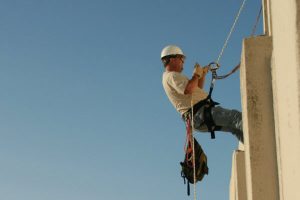
Fatalities and serious injuries from falls are still among OSHA’s Fatal Four hazards in the workplace.
Industrial Rope Access holds an enviable safety record, compared to all other work-at-height methods. According to the Society of Professional Rope Access Technicians (SPRAT) with over 7.5 million man-hours of work, there have been very few lost-time accidents.
Industrial Rope Access is a system in which people use a minimum of two independently anchored ropes and specialized hardware to access work areas. One rope is used for support and positioning, while the second rope is exclusively a backup system to prevent a fall should the primary system fail.
The equipment used in industrial rope access is designed specifically for this purpose. There are many recreational climbing products that are not compatible with industrial rope access systems. Knowing the difference is a matter of quality training and proper supervision.
Challenging Terrain and Height
Structural engineering projects often involve working in environments where traditional access methods, like scaffolding or aerial lifts, simply can’t access. Whether it’s the towering facade of a skyscraper, the intricate arches of a bridge, or the rugged terrain of an offshore platform, industrial rope access provides engineers with a direct route to areas that would otherwise be off-limits.
In scenarios where structures are situated in rugged terrain or extend to great heights, industrial rope access becomes indispensable. Instead of relying on cumbersome equipment or erecting elaborate scaffolding structures, engineers can swiftly ascend or descend using ropes, harnesses, and specialized equipment and techniques. This agility enables engineers and restoration contractors to conduct inspections, perform maintenance tasks, or carry out repairs with precision and efficiency, regardless of the terrain or height.
Inaccessible Areas and Confined Spaces
Structural integrity often hinges on the meticulous inspection of components tucked away in inaccessible corners or confined spaces. Whether it’s the interior chambers of a pipeline, the undersides of bridges, or the intricate framework within industrial installations, accessing these areas can pose significant challenges.
Industrial rope access offers engineers a nimble and adaptable solution for navigating confined spaces and accessing inaccessible areas. By using a two-rope system and techniques such as deviations, rebelays, vertical and horizontal aid climbing. Engineers and restoration contractors can descend into narrow shafts, ascend within confined chambers, or traverse complex structures with ease. This capability ensures that no critical component is left un-inspected, allowing engineers to identify potential issues early and implement timely solutions.
Emergency Situations and Rapid Response
In emergency situations, such as structural failures or natural disasters, time is of the essence. Traditional access methods may be too impractical or time-consuming, hindering rapid response efforts. Industrial rope access, however, offers engineers the ability to mobilize quickly and access affected areas with minimal delay.
In the aftermath of a disaster, structural engineers and restoration contractors equipped with industrial rope access training can swiftly assess the extent of damage, conduct emergency repairs, or implement temporary stabilization measures. The agility and efficiency of industrial rope access techniques facilitate rapid response efforts, helping to mitigate further risks and expedite the restoration of essential infrastructure.
Climbing to Great Heights to Evaluate Structures
Our Industrial Rope Access Forensic Team (RAFT) structural engineers are able to efficiently access, inspect, and conduct sampling and testing of building facades, roofs, bridges, dams, tanks, towers, confined spaces, and natural features not otherwise accessible with ladders or boom lifts. The team is experienced and practicing structural and forensic engineers, so as opposed to performing this work for other engineers, they are engineers themselves.
Our engineers have been performing this type of inspection work since 1995 across the country. Industrial rope access has been used in the United States for over 60 years. When used by trained professionals, industrial rope access techniques are safer, more efficient, and more cost effective than other traditional means of access height including scaffolding, swing stages, and cranes. Contact us today to learn more.
